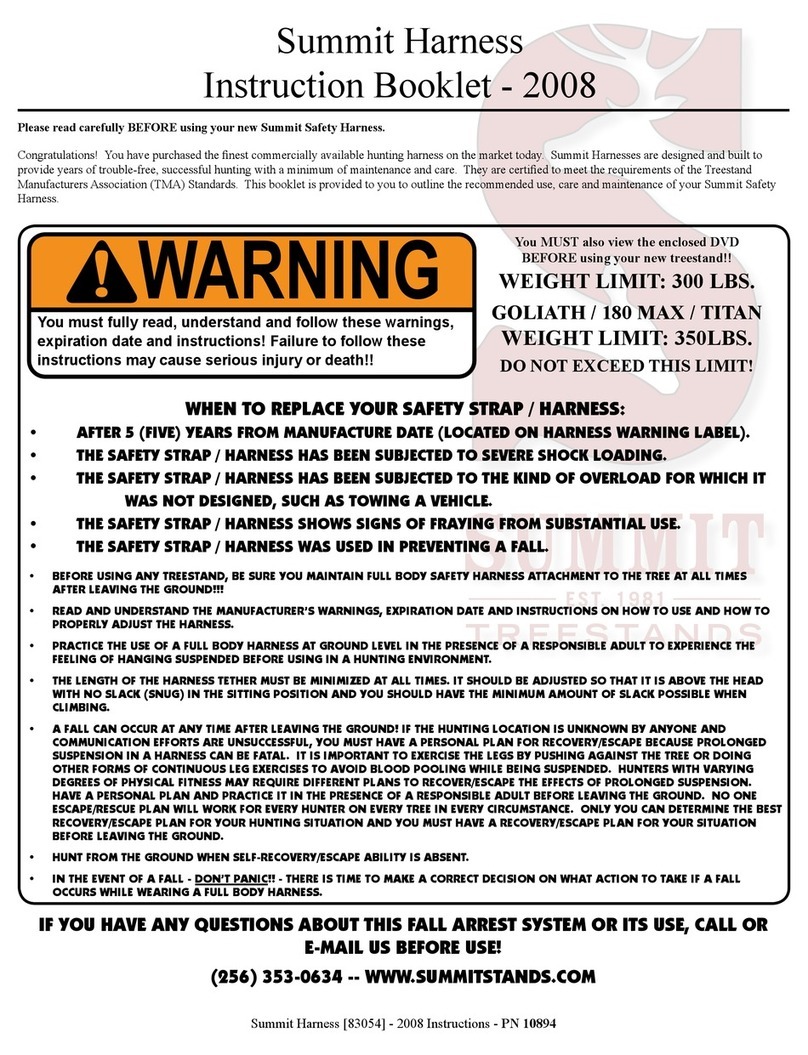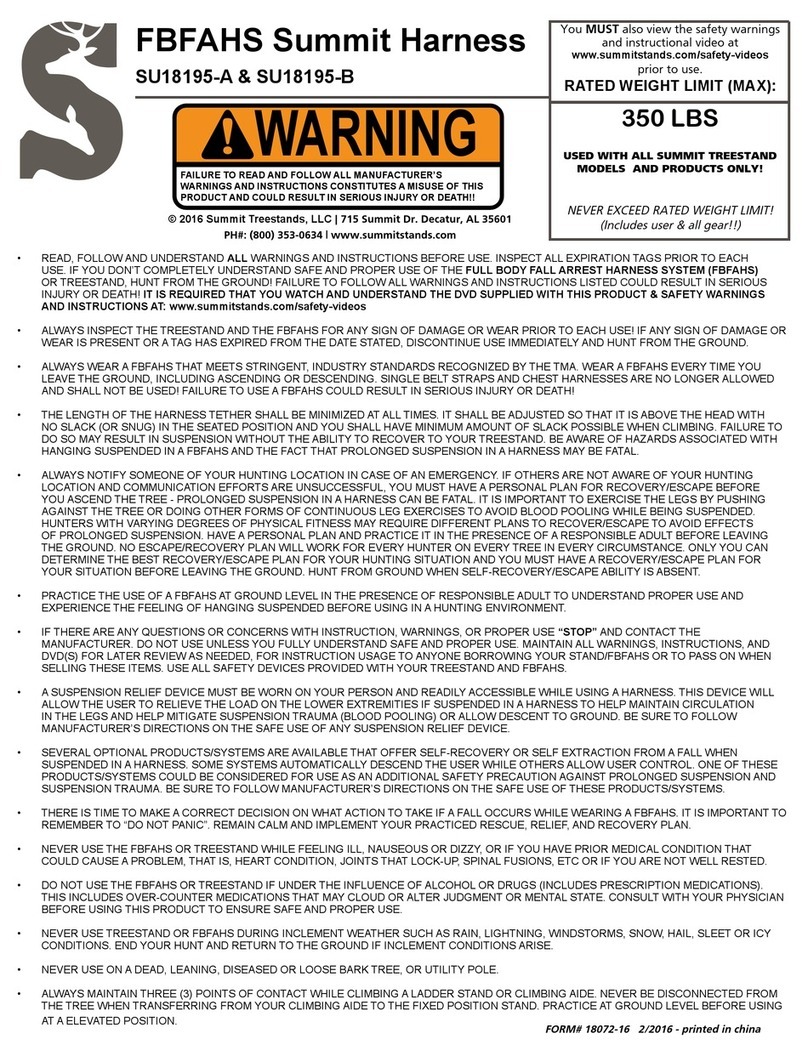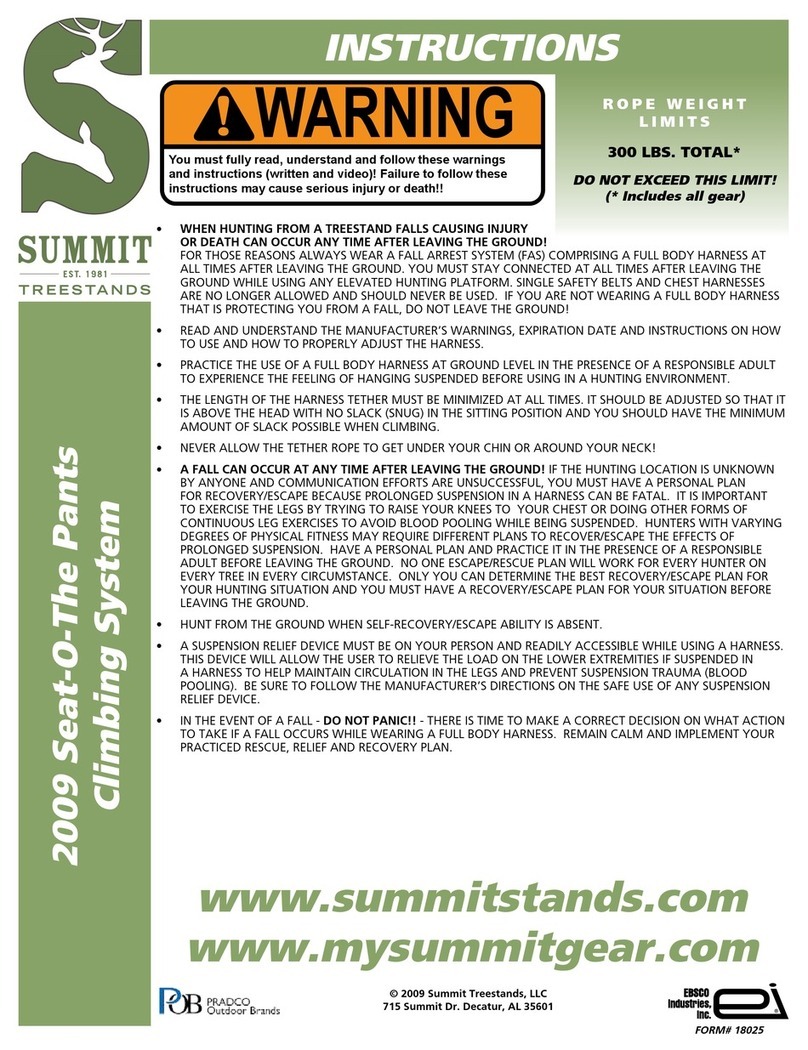
Figure 2
Harness Packaging:
The harness package contains one (1) harness, one (1) Treestand
Safety Rope, one (1) Attached pouch with Suspension Relief
Strap, one (1) locking clip, one (1) lineman’s clip, instructions
and DVD. The Cub comes with a 30’ safety rope.
Always check to make sure leg straps are secure
around legs and buckled before climbing the
tree!!!
Be sure the harness tether strap is attached to safety
rope!!
NEVER ALLOW THE TETHER STRAP TO GET
UNDER OR AROUND YOUR NECK as shown in
Figure 1.
If wearing harness under hunting clothes, make sure
your hunting clothes are not tight around your neck.
The harness will slip up if you fall as shown in Figure
2.
Always check harness webbing and hardware before
every use for any damaged or worn stitching, webbing
or hardware. If you nd a problem, DO NOT use
the harness until the problem has been resolved by
Summit Treestands, LLC.
If you fall, you must replace the harness by
contacting Summit Treestands, LLC.
This harness has been designed to be used only as a
safety device for hunting from elevated treestands and
ladder stands. Any other use is PROHIBITED!
Section 1 - Harness Instructions:
Part 1. Putting on the Harness:
Step 1. If you have the SOP Supreme, Fastback Deluxe or
Fastback Lite, simply put the harness on like a jacket. D-Rings
should be facing out on both sides. Slip your arms through the
shoulder straps. With the SOP Fastback and Fastback Lite,
pick the harness up by the tether strap to put it on.
Step 2. For all SOP harnesses - buckle the main belt around
your waist. Thread the buckle as shown in Figure 3 - Steps
1-4. Adjust belt strap by pulling on tag end until comfortably
snug as shown in Figure 4 and Figure 5.
Step 3. For the SOP Original, rotate the pouch to your front.
Unsnap the pouch and pull out the black tether strap (this strap
will act as a pull cord to pull out the shoulder straps). Once
the straps are out, rotate the pouch back behind you. Slip your
arms through the shoulder straps as you would a jacket. Be
sure the shoulder straps do not cross each other and that they
are not twisted.
Step 4. For all SOP models adjust the 3-bar slide on each
shoulder strap until the shoulder straps and waist belt are
comfortably snug as shown in Figure 6 and Figure 7.
Step 5. It is easier to adjust the leg straps before they are
•
•
•
•
•
WARNING
!
WARNING
!
Figure 1
NEVER ALLOW THE TETHER STRAP TO
GET UNDER OR AROUND YOUR NECK!
WARNING
!
PAGE 2
Figure 4
Figure 3
Step 1
Step 4
Step 1Step 1Step 2
Step 3
WARNING FOR CUB HARNESS USERS!!
If you purchased the Fastback Cub harness, you MUST to read this warning section!
THE CUB HARNESS IS NOT A TOY!
THE CUB HARNESS SHOULD BE THOROUGHLY INSPECTED EVERY TIME IT IS USED.
THE HARNESS INSTRUCTIONS MUST BE READ AND UNDERSTOOD FULLY.
THE CUB HARNESS SHOULD NEVER BE USED WITHOUT ADULT SUPERVISION!
THE CUB HARNESS IS DESIGNED FOR TREESTAND USE AND SHOULD NEVER BE USED FOR ANY OTHER APPLICATION.
IT IS IMPORTANT FOR THE ADULT AND YOUTH TO LEARN HOW TO USE THE CUB HARNESS PROPERLY.
THE CUB HARNESS WILL NOT COME WITH THE STANDARD SAFETY LINE, IT WILL HAVE THE SOP CLIMBING SYSTEM. THE CLIMBING SYSTEM
WILL ALLOW THE YOUTH TO ALWAYS BE ATTACHED TO THE HARNESS. THE INSTRUCTIONS FOR THE SOP CLIMBING SYSTEM ARE INCLUDED
IN THE PACKAGE.
•
•
•
•
•
•
•




























